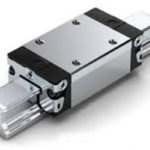When sizing a recirculating bearing, most designers and engineers focus on bearing life, which is based on dynamic load capacity. This is the load at which a linear recirculating bearing will, with 90 percent certainty, achieve the targeted service life before fatigue occurs. Static load capacity, on the other hand, is the force that causes permanent deformation of the rolling element (ball or roller) and raceway equaling 0.0001 times the rolling element diameter. If this deformation is exceeded, the running characteristics of the bearing will be degraded, resulting in vibration, noise, and increased friction.
As its name suggests, static load capacity is applicable only in a static (non-moving) state, and although it’s not used in bearing life calculations, static load capacity is an important parameter for recirculating linear bearings. Exceeding the static load capacity will certainly (not just statistically) compromise bearing performance.
Linear bearings are primarily associated with motion—for example, moving a tool, dispensing head, or load from one point to another—hence, the focus on dynamic load capacity in sizing and selection. But most linear guides also operate under static conditions for at least a part of their life. If the static load case is not taken into account, then a bearing that has a “theoretical” life of 150,000 meters, for example, may fail much earlier than this predicted life due to deformation caused by static loading.
Static loading generally occurs under one or more of the following conditions:
- The bearing is stationary but loaded for long periods of time.
- The bearing is loaded and moving at very slow speeds.
- The bearing experiences high shock loads.
Some examples of static loads are pressing forces, shock loads, and holding forces. For example, a drilling tool on the end of a linear guide will experience a static load when the guide stops moving and the drill is operating. Similarly, a vertically mounted guide is subjected to a static load when it holds a load at the top of the stroke. Shocks and vibrations, on the other hand, are often caused by conditions that are random, unpredictable, and/or difficult to quantify.
Static loads caused by shocks and vibrations are the most difficult to account for, and the reason that many manufacturers recommend a high static load safety factor for applications that are known to produce these types of loads.
Because a bearing’s static load capacity does not depend on distance traveled or time in use, the evaluation of static load is carried out by determining the static load safety factor. This is the ratio of the bearing’s rated static load capacity to the applied static load.

Where:
S0 = static load safety factor
C0 = static load capacity
F0max = maximum load (including shock or vibration loads)

When both forces and moments are present, the combined static load (also referred to as equivalent static load) should be calculated and used to determine the static load safety factor. In addition, as a general rule, if the applied load is less than 2.8 times the preload force on the bearing, then the preload force must be considered in the combined static load calculation.







Leave a Reply
You must be logged in to post a comment.